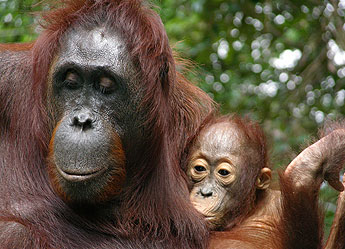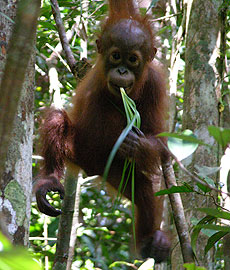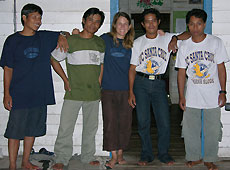 Research associate Erin Vogel is exploring whether orangutans' diet selection is simply opportunistic, based on geographical variation in what's available to eat, or whether it is learned. Photo: Erin Vogel Research associate Erin Vogel is exploring whether orangutans' diet selection is simply opportunistic, based on geographical variation in what's available to eat, or whether it is learned. Photo: Erin Vogel |
June 12, 2006
Researcher tracks orangutans for clues to feeding behavior
By Jennifer McNulty
Not many researchers can say they've had the privilege of dodging
orangutan spit deep in the tropical rain forest of Indonesia.
And it's a good bet that even fewer have sampled the dietary
fare of these magnificent apes.

The orangutans' food, above, tends to be very bitter, according to Erin Vogel, who tastes everything her subjects eat. Vogel, center, is joined by Indonesians working at the research site, below.
 |
Meet Erin Vogel, a leading expert on the diet and feeding habits of orangutans. A research associate in the Anthropology Department at UCSC, Vogel recently returned from a three-month research trip to central Kalimantan in the Indonesian region of Borneo, where she studies the diet and feeding behaviors of orangutans.
"I try everything they eat," said Vogel. "I figure if they can eat it, we can eat it. Most of it is really bad, though--high in tannins and very bitter."
Not that she's hoping to discover a fine delicacy. Rather, Vogel hopes to better understand the role of social learning in influencing diet selection among orangutans. As one of our closest ancestors, orangutans could shed light on the process of evolution and the transmission of learned behaviors.
"The social transfer of information in orangutans could be very similar to humans," said Vogel. "Social learning didn't just emerge with humans. It goes back much further. We're trying to gain an understanding of the evolution of this type of behavior."
In the tropical rain forest, Vogel is exploring whether diet selection is simply opportunistic, based on geographical variation in what's available to eat, or whether it is learned. So far, it appears to be a combination, said Vogel, who is collaborating with world-renowned orangutan expert Carel van Schaik, director of the Anthropological Institute and Museum at the University of Zurich.
| Recent UCSC graduate Tremaine Jones (B.A. anthropology, '05) had the experience of a lifetime when he accompanied research associate Erin Vogel on a three-month research trip to Indonesia. (Full story) |
Orangutans are highly endangered due to loss of habitat, poaching, and an illegal-yet-booming international pet trade. Vogel and van Schaik are studying more than 140 animals spread across four research sites.
Deep in the rain forest, seven hours by boat and car from the
nearest town, the Bornean Orangutan Survival Foundation operates
a primitive camp that serves as base for Vogel and up to two-dozen
foreign and Indonesian researchers. Locals from the nearest
village work as assistants and cooks at the camp, and for every
foreign student who visits the camp, van Schaik funds a six-month
research posting for an Indonesian university student. The foundation
also participates in reforestation and orangutan reintroduction
efforts, and runs security patrols to prevent illegal logging.
Like a proud parent, Vogel flips through dozens of photographs on her computer, sharing
memories and explaining unusual behaviors. Orangutan offspring spend eight years
on average with their mothers, giving the mothers ample time to teach their young where
food is, how to process it, and how to eat it, explained Vogel.
Most of what orangutans eat falls into one of two categories: seasonal fruits, and what Vogel calls "fallback foods," including bark, leaves, flowers, stalks, and stems. Fallback foods are abundant and regularly available but offer little nutrition, she said.
"Every four to six years there's tons of fruit, and our data indicate that diet optimization is at play," said Vogel. "But during the bad years, there's very little fruit, and they have to rely on fallback foods, which are harder to recognize as food." Vogel suspects that adults teach their young to forage on such fallback foods.
Orangutans forage on numerous species, from orchid roots to fruits that look like spaghetti squash. "They crack the thick husk and scoop out the insides," said Vogel. One softball-sized fruit is encased by a hard shell with fiberglass-like spines, but the orangutans make the effort to access the fatty, lipid-rich seeds inside, she said.
Curiously, orangutans in Sumatra use tools to eat the same foods that orangutans in Borneo eat without tools, noted Vogel. "They might use a stick to pry open a fruit for the seed or to get honey from a hive," she said.
Orangutans clearly have food preferences, sometimes spending hours devouring the fruit of a certain tree only to make a nest and return the next day to feast again. Other times they'll eat a few pieces of fruit and move on, she said.
Sometimes, orangutans will chew leaves, seeds, or pods into a fibery mess and then spit out the wad. When she's lucky, Vogel manages to duck before taking the hit.
As part of her research, Vogel is investigating the nutritional properties of everything the orangutans eat, as well as the stage of ripeness at which foods are consumed. "They only eat certain species at certain stages of ripeness, and some fruits they eat unripe," she noted (see sidebar). They also eat insects, larvae, birds, and in rare cases, mammals if they can catch them, she added.
Vogel focused on capuchin monkeys in Central America before embarking on this study of orangutans, but she's clearly smitten. She said she feels deeply contented when she watches them.
In the field from 4 a.m. until dusk, Vogel hovers at the base of trees and observes animals from distances of about 10 to 15 feet. Only one, the largest male, has ever displayed any aggression. Adult males weigh about 200 pounds, compared with about 100 pounds for females.
Vogel, who quickly became fluent in Indonesian, is struck by other differences among the orangutan populations of Borneo and Sumatra. For instance, orangutans in Borneo are more solitary, while orangutans in Sumatra have been known to gather in groups of eight to 10 in a single tree. Vogel thinks the food supply dictates their behavior. "If there was enough food in a tree to satiate them, I think they would congregate, because when they are together on occasion, they're very peaceful," she said.
Vogel's newest findings also helped researchers confirm the functional significance of differences between chimpanzees and orangutans. Because orangutans have the strongest jaws of the great apes, researchers expected them to consume harder foods than chimps, which have weaker jaws and thinner tooth enamel. "We tested it, and it's true," said Vogel, who collaborated with Nathaniel Dominy, assistant professor of anthropology at UCSC, on the comparison.
In July, Vogel will continue her research in Borneo and Sumatra, where one research site recently reopened after having been closed since 2000 due to political unrest. The research is supported by grants from the A. H. Schultz Foundation and the L. S. B. Leakey Foundation.